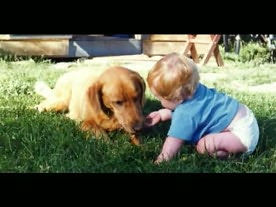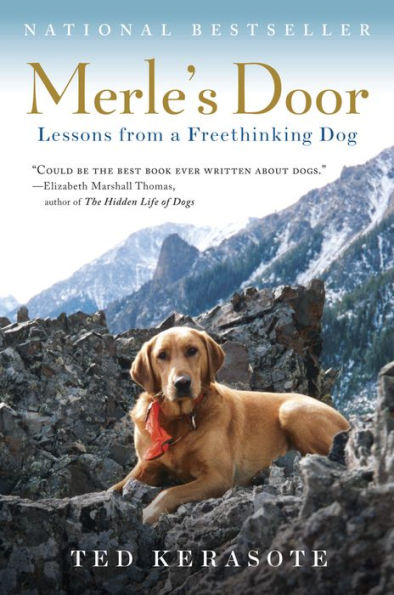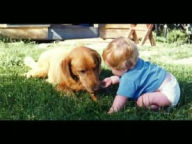

Paperback(First Edition)
-
PICK UP IN STORECheck Availability at Nearby Stores
Available within 2 business hours
Related collections and offers
Overview

Product Details
| ISBN-13: | 9780156034500 |
|---|---|
| Publisher: | HarperCollins |
| Publication date: | 04/21/2008 |
| Edition description: | First Edition |
| Pages: | 416 |
| Sales rank: | 122,158 |
| Product dimensions: | 7.96(w) x 5.34(h) x 1.12(d) |
About the Author

Read an Excerpt
chapter 1
From the Wild
He came out of the night, appearing suddenly in my headlights, a big, golden dog, panting, his front paws tapping the ground in an anxious little dance. Behind him, tall cottonwoods in their April bloom. Behind the grove, the San Juan River, moving quickly, dark and swollen with spring melt.
It was nearly midnight, and we were looking for a place to throw down our sleeping bags before starting our river trip in the morning. Next to me in the cab of the pickup sat Benj Sinclair, at his feet a midden of road-food wrappers smeared with the scent of corn dogs, onion rings, and burritos. Round-cheeked, Buddha-bellied, thirty-nine years old, Benj had spent his early years in the Peace Corps, in West Africa, and had developed a stomach that could digest anything. Behind him in the jump seat was Kim Reynolds, an Outward Bound instructor from Colorado known for her grace in a kayak and her long braid of brunette hair, which held the faint odor of a healthy, thirty-two-year-old woman who had sweated in the desert and hadn’t used deodorant. Like Benj and me, she had eaten a dinner of pizza in Moab, Utah, a hundred miles up the road where we’d met her. Like us, she gave off the scents of garlic, onions, tomato sauce, basil, oregano, and anchovies.
In the car that pulled up next to us were Pam Weiss and Bennett Austin. They had driven from Jackson Hole, Wyoming, to Moab in their own car, helped us rig the raft and shop for supplies, joined us for pizza, and, like us, wore neither perfume nor cologne. Pam was thirty-six, an Olympic ski racer, and Bennett, twenty-five, was trying to keep up with her. They had recently fallen in love and exuded a mixture of endorphins and pheromones.
People almost never describe other people in these terms—noting first their smells—for we’re primarily visual creatures and rely on our eyes for information. By contrast, the only really important sense-key for the big, golden dog, doing his little dance in the headlights, was our olfactory signatures, wafting to him as we opened the doors.
It was for this reason—smell—that I think he trotted directly to my door, leaned his head forward cautiously, and sniffed at my bare thigh. What mix of aromas went up his long snout at that very first moment of our meeting? What atavistic memories, what possibilities were triggered in his canine worldview as he untangled the mysteries of my sweat?
The big dog—now appearing reddish in the interior light of the truck and without a collar—took another reflective breath and studied me with excited consideration. Might it have been what I ate, and the subtle residue it left in my pores, that made him so interested in me? It was the only thing I could see (note my human use of “see” even while describing an olfactory phenomenon) that differentiated me from my friends. Like them, I skied, biked, and climbed, and was single. I had just turned forty-one, a compact man with chestnut hair and bright brown eyes. But when I ate meat, it was that of wild animals, not domestic ones—mostly elk and antelope along with the occasional grouse, duck, goose, and trout mixed in.
Was it their metabolized essence that intrigued him—some whiff of what our Paleolithic ancestors had shared? Smell is our oldest sense. It was the olfactory tissue at the top of our primeval nerve cords that evolved into our cerebral hemispheres, where thought is lodged. Perhaps the dog—a being who lived by his nose—knew a lot more about our connection than I could possibly imagine.
His deep brown eyes looked at me with luminous appreciation and said, “You need a dog, and I’m it.”
Unsettled by his uncanny read of me—I had been looking for a dog for over a year—I gave him a cordial pat and replied, “Good dog.”
His tail beat steadily, and he didn’t move, his eyes still saying, “You need a dog.”
As we got out of the cars and began to unpack our gear, I lost track of him. There was his head, now a tail, there a rufous flank moving among bare legs and sandals.
I threw my pad and bag down on the sand under a cottonwood, slipped into its silky warmth, turned over, and found him digging a nest by my side. Industriously, he scooped out the sand with his front paws, casting it between his hind legs before turning, turning, turning, and settling to face me. In the starlight, I could see one brow go up, the other down.
Of course, “brows” isn’t really the correct term, since dogs sweat only through their paws and have no need of brows to keep perspiration out of their eyes, as we do. Yet, certain breeds of dogs have darker hair over their eyes, what might be called “brow markings,” and he had them.
The Hidatsa, a Native American tribe of the northern Great Plains, believe that these sorts of dogs, whom they call “Four-Eyes,” are especially gentle and have magical powers. Stanley Coren, the astute canine psychologist from the University of British Columbia, has also noted that these “four-eyed” dogs obtained their reputation for psychic powers “because their expressions were easier to read than those of other dogs. The contrasting-colored spots make the movements of the muscles over the eye much more visible.”
In the starlight, the dog lying next to me raised one brow while lowering the other, implying curiosity mixed with concern over whether I’d let him stay.
“Night,” I said, giving him a pat. Then I closed my eyes.
When I opened them in the morning, he was still curled in his nest, looking directly at me.
“Hey,” I said.
Up went one brow, down went the other.
“I am yours,” his eyes said.
I let out a breath, unprepared for how his sweet, faintly hound-dog face—going from happiness to concern—left a cut under my heart. I had been looking at litters of Samoyeds, balls of white fur with bright black mischievous eyes. The perfect breed for a winter person like myself, I thought. But I couldn’t quite make myself bring one home. I had also seriously considered Labrador Retrievers, taken by their exuberant personalities and knowing that such a robust, energetic dog could easily share my life in the outdoors as well as be the bird dog I believed I wanted. But no Lab pup had given me that undeniable heart tug that said, “We are a team.”
The right brow of the dog lying by me went down as he held my eye. His left brow went up, implying, “You delayed with good reason.”
“Maybe,” I said, feeling my desire for a pedigree dog giving way. “Maybe,” I said once more to the dog whose eyes coasted across mine, returned, and lingered. He did have the looks of a reddish yellow Lab, I thought, at least from certain angles.
At the sound of my voice, he levered his head under my arm and brought his nose close to mine. Surprisingly, he didn’t try to lick me in that effusive gesture that many dogs use with someone they perceive as dominant to them, whether it be a person or another dog—a relic, some believe, of young wolves soliciting food from their parents and other adult wolves. The adults, not having hands to carry provisions, bring back meat in their stomachs. The pups lick their mouths, and the adults regurgitate the partly digested meat. Pups who eventually become alphas abandon subordinate licking. Lower-ranking wolves continue to display the behavior to higher-ranking wolves, as do a great many domestic dogs to people. This dog’s self-possession gave me pause. Was he not licking me because he considered us peers? Or did my body language—both of us being at the same level—allow him to feel somewhat of an equal? He circumspectly smelled my breath, and I, in turn, smelled his. His smelled sweet.
Whatever he smelled on mine, he liked it. “I am yours,” his eyes said again.
Disconcerted by his certainty about me, I got up and moved off. I didn’t want to abandon my plans for finding a pup who was only six to eight weeks old and whom I could shape to my liking. The dog read my energy and didn’t follow me. Instead, he went to the others, greeting them with a wagging tail and wide laughs of his toothy mouth. “Good morning, good morning, did you sleep well?” he seemed to be saying.
But as I organized my gear, I couldn’t keep my eyes from him. Despite his ribs showing, he appeared fit and strong, and looked like he had been living outside for quite a while, his hair matted with sprigs of grass and twigs. He was maybe fifty-five pounds, not filled out yet, his fox-colored fur hanging in loose folds, waiting for the adult dog that would be. He had a ridge of darker fur along his spine, short golden plumes on the backs of his legs, and a tuxedo-like bib of raised fur on his chest—just an outline of it—scattered with white flecks. His ears were soft and flannel-like, and hung slightly below the point of his jaw. His nose was lustrous black, he had equally shiny lips, and his teeth gleamed. His tail was large and powerful.
Copyright © 2007 by Ted Kerasote
All rights reserved. No part of this publication may be reproduced or transmitted in any form or by any means, electronic or mechanical, including photocopy, recording, or any information storage and retrieval system, without permission in writing from the publisher.
Requests for permission to make copies of any part of the work should be submitted online at www.harcourt.com/contact or mailed to the following address: Permissions Department, Harcourt, Inc., 6277 Sea Harbor Drive, Orlando, Florida 32887-6777.
Table of Contents
contentsprologue xiii
chapter 1: From the Wild 1
chapter 2: The First Dog 26
chapter 3: The Synaptic Kiss 49
chapter 4: In the Genes 67
chapter 5: Building the Door 97
chapter 6: Growing Into Himself 113
chapter 7: Top Dog 145
chapter 8: The Gray Cat 169
chapter 9: Estrogen Clouds 181
chapter 10: At Home in the Arms of the Country 194
chapter 11: The Problem of Me 210
chapter 12: The Mayor of Kelly 234
chapter 13: The Alpha Pair 249
chapter 14: White Muzzle 270
chapter 15: What Do Dogs Want? 284
chapter 16: A Looser Leash 304
chapter 17:t-family: 'Times New Roman'" The First Passing 313
chapter 18: Through the Door 327
with many thanks 363
notes 365
index 381
What People are Saying About This
"Reading Merle's Door involves more than just sailing through an engaging biography of a man sharing his life with a rare and free-spirited dog since it contains islands of useful and scientifically sound information about dog behavior as well. To be entertained and educated at the same time time is rare in dog books, which makes this one definitely worth reading."--(Stanley Coren, author of How Dogs Think)
"Lawlor's breezy, energetic reading fits perfectly with this account of the author's relationship with his pet." —-Booklist
"Merle’s Door is a window into the mind of a dog. You will experience his loyalty, fears, and joys and his true inner self. Everybody who loves dogs must read this book."--(Temple Grandin, author of Animals in Translation)
Related Subjects
Videos


